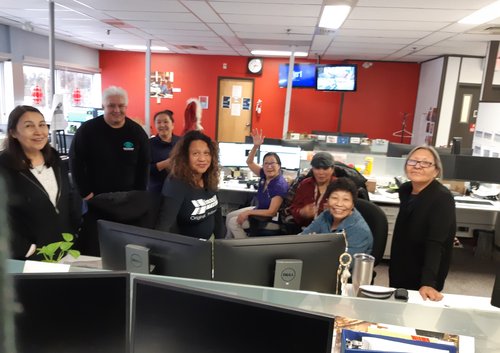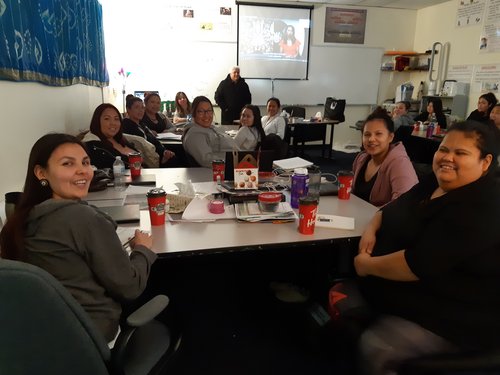
By David Klein
Gareth travelled to Canada for a conference and to spend time with First Nations archiving staff, after winning the 2019 Paul Reynolds 'No Numpties' Grant.
Even a long way from home, things can be pretty familiar. “I was surprised by how similar I saw ourselves culturally,” says Seymour. “There’s all these practices and actions that they did that were the same as in Aotearoa. There were definitely more similarities than differences.”
Seymour travelled to a couple of locations week-long visit. In Saskatoon, Saskatchewan he attended the Saskatchewan Indigenous Cultural Centre (SICC) First Nations Language Keepers Gathering – a huge event for those involved with indigenous language. “There was a thousand people from all over Canada. It was a really huge opportunity to talk with people about what they were doing, where their language is at, and to work out how the languages are connected.”
Making those connections in the first place can be tricky. Unfamiliar with all the terms, Seymour found it challenging to figure out if something was the name of a language, a place or a whole First Nation of people. “They were rattling off names and it kind of meant nothing to me. I’ve got to say there was very little that I knew of First Nation people. Our knowledge is pretty superficial in New Zealand,” he reflects, “though that’s probably how outsiders experience te reo and Māori culture”.
Despite his limited knowledge, he was warmly welcomed by all that he met. The Māori concept of manaakitanga crossed languages. “I was taken around all these agencies to meet people; I met the mayor. It seemed like ‘oh, we have a visitor from a long way away – come and meet everybody.’”
Following the SICC in Saskatoon, Seymour spent a week in Yellowknife, Northwest Territory. He was hosted by the Canadian Broadcasting Corporation (CBC) where more connections were revealed. “They’ve got an indigenous archiving project and so does Ngā Taonga. They’re a state broadcaster with a collection; we hold material from RNZ and TVNZ.”
“At the CBC, I spent most of my time with indigenous cataloguers and sat in on their archiving projects.” There are nine indigenous languages in Northwest Territory, making it rather more complicated than in Aotearoa. This results in plenty of multi-tasking. “One of the cataloguers said to their colleague, ‘I’m doing an interview with this guy but he doesn’t speak English – could you come in and interpret for them?’ They’ve got people who don’t speak English because they’re from really isolated places.”
There’s also a high degree of language proficiency. “I spent time in the studio at CBC,” says Seymour. “What was interesting was the script on the teleprompter was in English and the presenter was live-translating it because they didn’t have the capacity to develop Inuktitut script. She must be pretty skilful to stand there and just look like she’s just reading the news, but is actually translating.”
Hero image: The indigenous cataloguing team at CBC in Yellowknife. (Gareth Seymour is second from left.)

Gareth Seymour (beside projector screen) presenting to a group of indigenous students in Yellowknife.
There were more surprises with people that he met, especially regarding culture similarities. He found a number of practices, actions and concepts that were the same – things like taha wairua. “Spiritually, linguistically, culturally – there was so much that we had in common. You know that you’re going to a Māori house because there’s 20 pairs of shoes on the porch. Their offices were like that, though there was also a practical reason for that with the snow and the mud,” Seymour jokes.
The concept of kaitiaki was of great interest to the archiving staff. “They’ve got great resources and have been digitizing the collections, but they haven’t reached the sharing stage.” Ngā Taonga has relationships and agreements with iwi and depositors. We care for the material but don’t own it, and liaise with depositors before agreeing for it to be shown or reused. “At this stage for CBC it’s feeling like a mountain to overcome. But I talked through how our system worked and with a little bit of policy and process, you can sort out if something can be placed online, or shared with people.”
Another strong theme that ran through Seymour’s trip was language revitalization. Similar to the kōhanga reo method created in Aotearoa, ‘language nests’ have been developed in many indigenous language communities across North America and around the world. “There were similar initiatives. They’ve got immersion programmes, they’re producing books, producing apps, producing dictionaries.”
“They talk about language nests,” reflects Seymour, “but I don’t think they know that concept came from Aotearoa – I’m pretty sure that Māori pioneered it. That connection is lost, but that’s okay.”
“There’s some language speakers in Northwest Territories who were interested in the fact that we had a writing system. Some of them didn’t have writing systems until 20 years ago and some of them were still being developed. For the untrained eye it looks like Greek or Mandarin.”
In other ways, Canada provides a vision of how Aotearoa could be in the future. It’s a fully bilingual country with both English and French, on planes, trains, public services. State broadcasting is in parallel with both languages, and bilingual politicians is the norm. There are full immersion French options in schools across the country. The multiple indigenous languages of the Northwest Territory is probably closer to the current New Zealand. “There’s multilingual legislation that includes the nine indigenous languages,” says Seymour. “Like Māori, they’re evident in some public spaces but not fully implemented.”
A long way from Aotearoa, Seymour made connections with indigenous communities and found similarities that reinforced those bonds. Though there were differences in language use and culture, there was a common purpose. “We’re at different places on the same journey.”